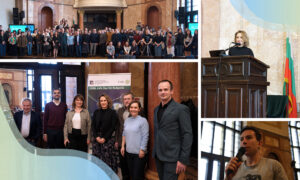
EMBL and Australia – delivering excellence
Opinion: Silke Schumacher, EMBL’s Director of International Relations, explains how Australia’s associate membership of EMBL empowers scientists and drives training and collaborations

My role as EMBL’s Director of International Relations involves travel to ministries and institutes all over the world. While some might think that spending a lot of time on the road can be a lonely business, one of the great parts of my job is that wherever I go, I meet people from EMBL’s global community – from our member states, alumni, partners, collaborators and more.
One recent example is a visit I paid to the Garvan Institute of Medical Research in Sydney, Australia to give a speech at a conference organised jointly by EMBL’s Alumni Relations and my office. The event provided a terrific opportunity to connect with EMBL alumni working across the country, researchers from EMBL partner institutions and others looking to link to our network. It was also a great opportunity to learn more about the wide range of important research projects that have been initiated as a direct result of long-standing ties between EMBL and scientific institutes in Australia – partnerships that we want to continuously nurture and develop.
Close neighbours
Australia is, of course, on the other side of the world from EMBL’s six sites in Europe. But EMBL and Australia are more like close neighbours in the way we collaborate in research projects and infrastructure resources. Australia hosts an exceptional science ecosystem, particularly in the areas of health and medical research, and Australian researchers and institutes have benefitted greatly from access to EMBL’s expertise in areas such as systems biology and bioinformatics.
Such deep-rooted connections led to Australia joining EMBL as the Laboratory’s first associate member state in 2008. When Australia joined EMBL, we put in place a board of experts from Australian academic and research institutes and EMBL. Its task is to oversee activities and provide guidance in key areas such as research infrastructure development, scientific direction, and training. The initiative has been a success, and the associate membership was duly renewed in 2015.
We were also able to develop a network of partner institutes, and it will soon host up to 20 research groups in six institutes spread across the country. The Secretariat of the Partnership Network is hosted by Monash University research groups cover topics as diverse as neurobiology, antibiotic resistance, immune regulation, ageing, cancer and much more besides.
Partnerships are something that EMBL offers to all member and associate member states – a way to form closer links between EMBL and research institutes at the national level. While there is no transfer of funding to the country, EMBL provides expertise in establishing the partnership, recruitment of faculty, scientific evaluations and the development of training programmes. The exceptional quality of research within the Australian network is a clear demonstration of the value of these partnerships.
Meanwhile, with the support of EMBL expertise and resources, Australia is developing a national network of bioinformatics capabilities – the hub of this initiative, called the EMBL Australia Bioinformatics Resource, is at Melbourne University – which supports data collection, integration, sharing, and analysis. It also promotes training in data, tools and platforms, as well as unified approaches to data management, software tools, computational platforms and services.
Everything open
As an EMBL associate member state Australia can gain access to infrastructure, scientific networks, funding and collaborators – all of it open and accessible to the entire national research community.
Much of EMBL’s science continues to be focused on interactions at the European level – we will always be European at our core. But by bringing in selected nations as associate members – where existing ties are strong and the mutual benefits are palpable – EMBL can drive science and technology development, launch careers, inspire collaborations and enhance our platform of fundamental research and scientific service provision for the good of our societies.


